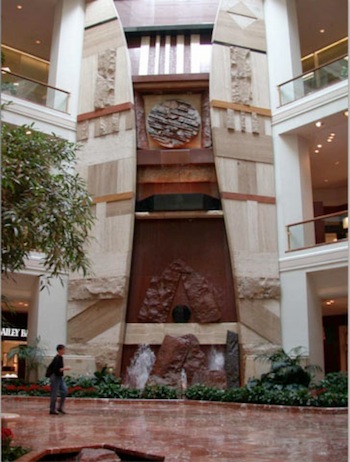Arts Commentary: To Stay or Not to Stay? Copley Place’s fountain faces an uphill battle
Today, the fountain at Copley Place feels embarrassing in some way; not its form or execution, but its very existence.
By Margaret Weigel
In our postmodern society driven by private and commercial interests, is public art an anachronism? Is it only an expensive anachronism that needs ongoing maintenance paid with public funds in a time of fiscal austerity for art that — if you’re lucky — a plurality of residents like or even know about? In truth, much of what is considered public artwork today is less about art than business. It is a panacea for areas overrun by commerce — to entice tourists to parks, tenants to office parks, and shoppers to retail establishments – and to serve as a respite for the weary visitor to help them forget they just worked fifty hours last week. Still, the era of commemorating white male war heroes – or brutal conquerers, depending on your point of view – in bronze in the Public Garden has morphed into more sophisticated and commercial iterations, such as public performances and temporary installations that delight and educate. The city of Cambridge is to be commended for its ongoing commitment to excellent public art such as the ROUND collection of city public art locations, complete with visitor comments. The city of Boston, not so much.
And this brings us to the Curious Case of The Copley Place Fountain. Copley Place opened in 1984-5 as a high-end shopping mall in the Dallas and Dynasty, shoulder-pad, teased-hair tradition, loaded with luxurious materials and stores intended to lure a higher class of clientele south of Newbury Street. The developers, the wealthy Pritzker famiy of Chicago, Ill., commissioned Dimitri Hadzi, a well-known sculptor and educator based at Harvard, to create the site-specific work for the space. And when the mall opened, his enormous 60′ fountain fashioned out of marble and granite surrounded by (marble) benches was situated at its center, providing shoppers the opportunity to sit, rest, and enjoy the gentle gurgling of the water amidst the glitz.
But styles change, and as the 1980s gave way to the 1990s and 2000s, Hadzi’s sculptural style — European, abstract, post-Cubist products created out of rough-hewn stone and metal — fell out of fashion, much like bronze war heroes, Brutalist architecture and shoulder pads. Hadzi passed away in 2006; at some point, the fountain’s water was shut off. It is unclear whether this was a business decision, an environmental one, or a malfunction that was never repaired. Pritzker sold the property to Simon Malls, the company behind Kittery and Wrentham Premium Outlets and approximately 100 malls in the U.S. and around the world, in the late 1990s. And now the Simon Property Group is itching to get rid of this site-specific work as part of a master plan to increase retail space, add housing and – wait for it – “[contribute] up to $1 million towards new public art and $250,000 to the Friends of Copley Square.”
Christine Hadzi, the sculpture’s widow and a longtime Cambridge resident, told me she was invited to a meeting in 2010 with the developers and architect during which they revealed their intention to remove the foundation. They suggested that the fountain could be relocated to another spot and, much to her amusement, they suggested shipping it to Rome. Costs for shipping the multi-ton behemoth were not discussed. Another Hadzi sculpture, this one in Harvard Square, only very recently received a stay of execution by the MBTA thanks in large part of Hadzi and the support of Romolo del Deo, a former student and fellow artist. (For an update on the fate of the Harvard Square sculpture see comment below from Romolo de Deo.)
Today, the fountain at Copley Place feels embarrassing in some way; not its form or execution, but its very existence. It is an uncomfortable reminder of a time when greed and consumption were exalted, and we had just unwittingly signed up for what turned out to be a thirty-year economic strip mine operation against, as it turns out, ourselves (unless you are part of the 1%). In the wake of the Occupy protests, a culture that is scaling down either by force or by choice, Copley Place is a bit like that yearbook photo that we laugh at – and cringe at — years later.
The Simon Property Group is eager to expand Copley Square’s retail holdings, and argue that the fountain adversely affects the businesses located behind it because they are less visible to passersby. It may be eager to replace it with more contemporary work. The group technically owns the sculpture and will ultimately decide its fate. Whether the public is invested enough in preserving a site specific sculpture from a moderately-known artist rendered in a style currently out of fashion remains to be seen.
One final note: above the counter at my local post office is a large mural from the WPA days that depicts, in meticulous and unmistakable detail, our role in the fabled sugar-rum-slaves triangle. Many have argued that it is grossly offensive and should be painted over. Others appreciate it from a historical viewpoint and ignore the scene’s disturbing message. I would prefer that the mural stayed, but framed by an educational message. I think that some clever architects could modernize the Copley Place space in ways that could maintain the fountain in some form. At least they could manage to turn the water back on.
Margaret Weigel is a longtime Boston area arts and culture critic focusing on public art and the delineation of public/private space, shifting definitions of art, games, and audience engagements.
Tagged: Copley Place, Dimitri Hadzi, fountain, Omphalos



The “Center of the Universe” is no longer in Harvard Square. The MBTA is allowing a Rockport development group to remove Omphalos from Harvard Square and relocate it to their beachside development. And while we are grateful to those developers for saving the sculpture, we feel far less charitable toward the T, who fabricated this crisis, and Drew Faust, who refused to even take calls on the matter, even from well-placed, concerned alumni.
Today Harvard launches their new funding campaign. Please feel free to let the dear alma mater know how you feel about their stony-hearted treatment toward saving one of their own in stone. And thank you sincerely, to all those who tried so hard to save this piece of Harvard’s history for Harvard. Maybe one day, Harvard won’t treat public art by it’s alumni and faculty like comparative second class endeavors. There has to be some sculpture they can find a place for in their spacious grounds and cold hearts by someone besides Daniel Chester French.
For Arts Fuse coverage of the fate of Omphalos, go here.
Incidentally, Daniel Chester French was an MIT alumnus, as noted in his Wikipedia article.
The article says this about the fountain: “It is an uncomfortable reminder of a time when greed and consumption were exalted.”
I don’t see how a nice piece of homage to nature such as the fountain exalts “greed and consumption” anymore than dp the high-priced shops, restaurants, plays, concerts, cars, housing and just about everything that is in Boston, greater Boston, and most big cities in the US. Are we sure this is not just liberal guilt at work here?
I’m with you. It is a terrible loss to remove that sculpture. Where is it now? In a landfill? What took it’s place?
I totally agree, Terry. I immediately fell in love with that fountain when I first saw it in 1986 when I moved to the area (and stayed until 1997). I’d visit Copley just about every weekend and enjoyed its calming, splashing waters amidst the crowds in the mall. Little did I know that a trip back to Copley in 2014 would be the last time I’d ever see the fountain. And if it’s true that – as the author states – the era in which the fountain was operable was “greed and consumption”, does that make the current era of “hatred and destruction” of anything artistic and historic legitimate? Sounds like a lot of brainwashing from “progressive” thought to me.